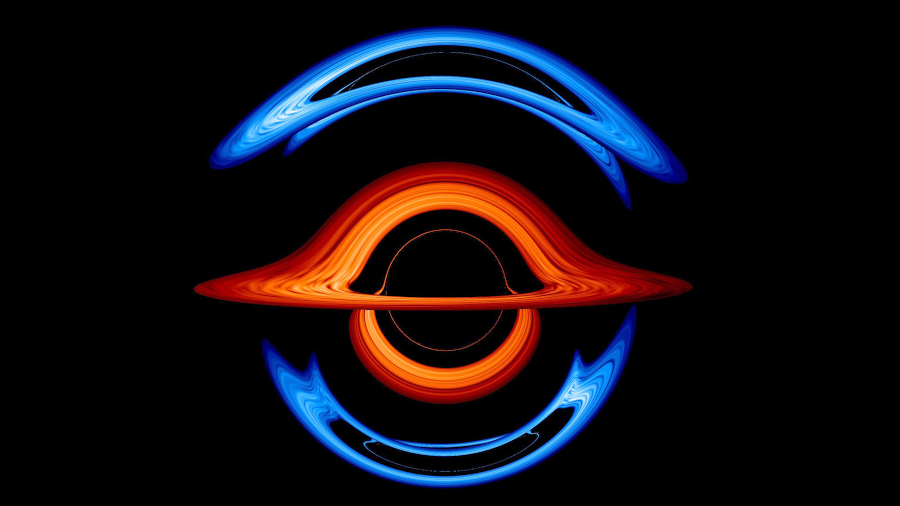
 Credit: NASA's Goddard Space Flight Center/Jeremy Schnittman and Brian P. Powell
Credit: NASA's Goddard Space Flight Center/Jeremy Schnittman and Brian P. Powell
Gravity's Warped Rainbows
Light travels along strange paths through our material Universe. Mass bends spacetime, as Einstein showed, altering these paths. The curving of spacetime allows us to see things which would be otherwise hidden. Black holes alter the geometry of spacetime in the most extreme way, bending spacetime so much that near the black hole there's no longer any open path for light to escape. Black holes are often surrounded by a thin, hot, glowing disk of matter spiralling into the black hole. Because of the effects of a black hole's gravity,
the light from a uniform, thin glowing disk around a black hole is distorted: light from one edge of the disk appears brighter than the other, and light from the accretion disk behind the black hole is bent around the black hole and appears as a glowing band above and below disk plane. This was famously illustrated by Gargantua, the accreting black hole which starred in the movie Interstellar, and these effects have now been seen in real life thanks to the Event Horizon Telescope. But black holes don't necessarily exist in isolation, and spacetime gets even more complicated when one black hole is near another one, as might happen near the centers of some galaxies. Binary black holes, containing millions or even billions of times the mass of the Sun, could be produced by the mergers of galaxies each containing a central supermassive black hole. In such galactic mergers, two supermassive black holes can spiral together, orbiting each other before the black holes collide to become an ever more supermassive black hole (and generate Universe-shaking gravitational waves in the process).
We can now see this interesting situation thanks to a new supercomputer movie which shows the complex, changing distortions of spacetime when two supermassive black holes, one with a mass of 200 million Suns and the other with a mass of 100 million Suns, orbit around each other. A still from this movie is shown above. In this image, the more massive black hole (whose accretion disk is colored red) is in front of the less massive black hole (whose accretion disk is colored blue). In the simulation, our view is in the black hole orbital plane, which coincides with the plane of the accretion disks around the two black holes. This image highlights how light struggles to emerge from the accretion disk of the less massive black hole through the warped spacetime near the binary. Currently we don't know how whether such binary supermassive black hole systems are common in the Universe, or rare. This question may be answered by LISA, the Laser Interferometer Space Antenna, a space-based gravitational wave detector sensitive to the gravitational radiation produced by merging supermassive black holes.
Published: May 17, 2021
<
HEA Dictionary ● Archive
● Search HEAPOW
● Other Languages
● HEAPOW on Facebook
● Download all Images
● Education ● HEAD
>

Each week the HEASARC
brings you new, exciting and beautiful images from X-ray and Gamma ray
astronomy. Check back each week and be sure to check out the HEAPOW archive!
Page Author: Dr. Michael F. Corcoran
Last modified Monday, 26-Feb-2024 17:20:21 EST


